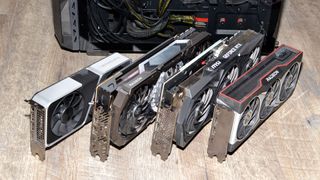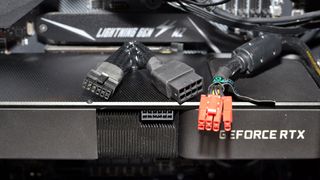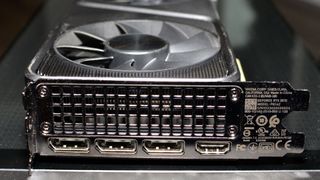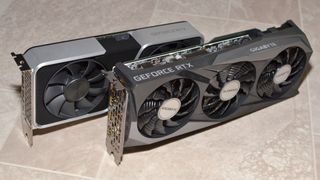Getting the best graphics card is key if you're looking to buy the best gaming PC or looking to build a PC on your own. The graphics card is even more important than the CPU. But for the uninitiated, the process of figuring out which GPU to buy can be intimidating. There's so much to consider, from the type of monitor you're using (for recommendations, see our Best Gaming Monitors page) to the size of your PC case to the game settings you plan to play at.
In this article, we're going to cover the things you need to keep in mind when shopping for your next GPU. For specific recommendations, see our best graphics cards list of the current options, as well as the GPU benchmarks hierarchy to see how today's cards compare to older cards that you might be looking to upgrade and replace.
Supply and demand affect GPU prices on AMD, Nvidia, and Intel GPUs, with new models regularly replacing older options, but previous generation parts remain viable. As you'd expect, the best options these days will generally come from the latest Nvidia RTX 40-series and AMD RX 7000-series GPUs, with Intel Arc GPUs providing some competition at the budget end of the spectrum. All three companies are slated to release new models in the next six months, give or take, which usually means faster and more efficient hardware with some new features, but not usually lower prices.
Quick TipsWhy you can trust Tom's Hardware Our expert reviewers spend hours testing and comparing products and services so you can choose the best for you. Find out more about how we test.

There are hundreds of graphics cards from dozens of manufacturers, but only three main companies actually make the GPUs that power these components: Nvidia and AMD are the main contenders, though Intel Arc Alchemist GPUs are also available. There are some Chinese GPU companies working to enter the market, but performance and features are far behind the others for the time being.
Nvidia dominates the market, using its position to push new technologies including things like DLSS 3 Frame Generation, DLSS 3.5 Ray Reconstruction, AI and deep learning, and the original DLSS 2 upscaling. AMD has alternatives to most of these, but outside of FSR2 upscaling, it's not really keeping up. For example, FSR3 Frame Generation now exists, but our experience hasn't been great — though we'd say the same thing about Nvidia's framegen tech: It's questionable at be st. Nvidia's RTX 40-series GPUs, from the top RTX 4090 down to the mainstream RTX 4060, are all efficient, offer good features, and generally cost more than the competition.
AMD's RX 7000-series GPUs perform best in rasterization games, with generally competitive pricing and more VRAM at similar price points compared to what Nvidia offers. The 8GB of VRAM on the RTX 4060 Ti is particularly galling and represents a step back from the 3060 12GB. But generationally, the lower tier RX 7800 XT, RX 7700 XT, and RX 7600 don't offer much more than their outgoing predecessors from the 6000-series. Only the RX 7900 XT and RX 7900 XTX deliver new levels of performance.
For now, Intel functions as a value alternative. The Arc A750 and Arc A580 may be relatively inexpensive for the level of performance offered, but they use more power than the competing AMD and Nvidia alternatives, and at best the A750 matches the previous generation RTX 3060 — Intel has no answer for the RTX 4060 and above, until it's next-gen Battlemage GPUs begin shipping (which are expected to arrive in late 2024). AMD's RX 6600 and RX 6650 XT are also strong alternatives to Intel's Arc GPUs, and while drivers continue to improve, Intel isn't out of the woods yet.
Here's what the overall performance picture looks like, across out latest 15-game test suite, using nine pure rasterization games and six ray tracing games.
Image 1 of 4
(Image credit: Tom's Hardware)(Image credit: Tom's Hardware)(Image credit: Tom's Hardware)(Image credit: Tom's Hardware)We should also discuss the realistically lit elephant in the room: real-time ray tracing. Originally introduced with Nvidia's RTX 20-series Turing cards, DirectX Raytracing (DXR) has been slowly gaining momentum. AMD and Intel GPUs also support DXR (and VulkanRT), but Nvidia is now on its third generation RTX 40-series GPUs, and there are games — like Alan Wake 2 and Cyberpunk 2077 Phantom Liberty — where there's a massive gulf in performance and image fidelity when looking at Nvidia versus the competition.
The number of games that make good use of ray tracing still remains somewhat limited, however. There's no doubt that more games are adding RT support, but many of those only seem to have superficial improvements in image quality thanks to the tech. Simply put, doing only shadows, ambient occlusion, reflections, or any other single RT effect isn't likely to make a huge difference. But the more RT effects that are used, the bigger the performance hit becomes — again, check our Alan Wake 2 coverage (linked above) to see just how big the gulf between Nvidia and the competition becomes once path tracing gets enabled.
Our GPU ray tracing benchmarks break things down using five reasonably demanding RT games (meaning, outside of Minecraft, nothing is doing full path tracing). Games that only use a single RT effect, like reflections, tend to be less demanding and less impressive overall. So w eigh the importance of ray tracing performance with how interested you are in these games, how important the best possible visuals are to your enjoyment, and how much future-proofing you want baked into your GPU.
Also, don't forget DLSS, Nvidia's AI-assisted resolution upscaling that has now expanded into other areas including Frame Generation (DLSS 3) and Ray Reconstruction (DLSS 3.5). While AMD's FSR aims to compete with DLSS on some levels, the number of games with FSR 3 Frame Generation is quite small right now (two), and there's no alternative to Ray Reconstruction. Ultimately, DLSS can deliver improved performance and potentially visual fidelity with less of a performance hit.
Support for DLSS is limited to a subset of games, admittedly a growing one — there are currently over 440 games with DLSS support of some form, and Nvidia tends to announce several more each week. AMD's FSR 2/3 is currently used in 201 games, meaning DLSS 2 or later is supported in over twi ce as many games. XeSS splits the difference in quality between DLSS and FSR 2, using Intel's XMX cores to do AI upscaling, but it's in even fewer games than FSR: 120 games currently support XeSS. Do note that FSR and XeSS can both work with all GPUs, however, whereas DLSS only supports Nvidia RTX cards.
For more on these subjects as well as screen-smoothing variable refresh technologies, see our AMD vs Nvidia and FreeSync vs. G-Sync features.
How Much Can You Spend?The price of video cards varies greatly, with super low-end cards starting under $100 and high-end models going for up to $2,000 or more in the case of custom GeForce RTX 4090 models. The top-end cards generally aren't worth the money unless you absolutely have to have the best performance possible, though the 4090 does offer some tangible benefits over the next step down RTX 4080 / 4080 Super.
Nvidia and AMD have generally altered their lineups with the latest models so that you now get performance sca ling almost directly in proportion to price. Where the RTX 3080 nominally cost $700 compared to the RTX 3090's $1,500, this generation the 4080 costs $1,200 while the 4090 costs $1,600: Up to 30% more performance for 33% more money, in short. (The newer RTX 4080 Super adjusts the penultimate GPU down to $1,000, however.)
Even so, dropping a couple of notches will improve the bang for the buck. The RTX 4070 starts at $540 and the RTX 4060 Ti 8GB starts at $370. Meanwhile, an RTX 4080 Super starts at $1,000. That's nearly triple the price of the 4060 Ti for about double the performance, or up to 60% higher performance than the 4070 for double the price. Similarly, AMD's top RX 7900 XTX starts at $900 while the RX 7800 XT starts at $500. The more expensive card offers about 50% more performance for nearly double the price.
AMD's previous generation RX 6000-series are also potentially worth a look, as they can deliver at least relatively similar performance in many games com pared to the newer parts. Nvidia's RTX 30-series meanwhile is only worth considering if you can find one on steep discount, or if you're willing to consider buying a used graphics card. Check our GPU price index for regularly updated pricing on the various GPUs, but here's the short list we're tracking right now:
Swipe to scroll horizontallyWhich GPUs are budget, mainstream, and high-end?It's easy to get lost arguing semantics. When we say "budget," are we talking about price or performance? It's a bit of both, really, and what was once a top-tier "high-end" GPU will inevitably become "mainstream" and then "budget."
The best resource we have for how the GPUs stack up against each other is our GPU benchmarks hierarchy, which breaks things down by rasterization and ray tracing performance. The latter category of course eliminates many GPUs from consideration — any GTX series Nvidia card, or AMD cards from the RX 5000-series or earlier.
If you currently own, for exa mple, an RTX 2060 and you're feeling the need to upgrade, you can search for that card to find that it averaged 56 fps at 1080p ultra in our rasterization tests, and 38 fps in our ray tracing tests. Looking at the two generations newer RTX 4060, it's 52% faster in rasterization performance and 55% faster in ray tracing performance. If you want a GPU that's double the performance of the RTX 2060, you'll want to get at least an RTX 4070 or RX 7800 XT (give or take).
How to buy a GPU: Which specs matter and which don't?

If you want to use your GPU with a PC VR HMD, you need at least a midrange card. Some VR games are a lot more demanding, however, so while an RTX 2060 in theory might suffi ce, you might be better off with an RTX 4080, RX 7900 XT, or similar. The card requirements of course increase with newer, higher-resolution headsets. Obviously, this isn't a critical factory if you have no interest in VR.
What about ray tracing and AI?We discussed this above, but to briefly recap, Nvidia's RTX GPUs are the best solution for ray tracing, and also the only solution for DLSS. AMD's RX 7000-series GPUs can compete with Nvidia's 30-series in ray tracing, more or less, but heavier RT workloads (like path tracing) may require an Nvidia 40-series GPU to have a chance at decent performance. Intel's Arc GPUs are about the same level of RT performance as the RTX 3060 for the A750/A770, and a bit slower for the A580.
AMD and Intel both have alternatives to DLSS, in the form of FSR (2/3 now) and XeSS. Uptake of FSR has been pretty good overall, XeSS somewhat less so. For the most demanding games, upscaling is almost a pre-requisite these days.
Game support fo r DXR (DirectX Raytracing) and DLSS/FSR2/XeSS continues to improve, but there are tons of games where it's simply not an important consideration. If you like to turn on all the bells and whistles, placebo effect increases in image quality be damned, that's fine.
We still expect RT performance to become increasingly important in the coming years. If you want to see what all the fuss is about, Phantom Liberty and Alan Wake 2 with full path tracing look better... and run about 80% slower than with pure rasterization. It could be two or three more GPU architectures before full ray tracing truly goes mainstream.
Reference Card or Third Party Design?
Even after you decide what GPU you're after, you'll usually be faced with plenty of options in terms of cooler design and brand or manufacturer. Nvidia makes and sells its own cards under the Founders Edition moniker for higher-end models, while AMD licenses its reference design to other manufacturers. Both companies' GPUs appear in third-party cards from several different vendors. Intel made reference des igns on the A770 and A750, but those are mostly phased out now.
More expensive third-party cards will have elaborate coolers, extra fans, lots of RGB lighting, and often higher clock speeds, but they can also be more expensive than the reference card. Overclocking improvements are often minimal, with gains of just a few FPS, so don't feel bad if you're not running a blinged-out card. That said, beefier cooling can often translate to cooler, quieter operation, which can be important given that high-end graphics cards are usually the noisiest, most heat-generating parts in a PC build.
Card Recommendations by Resolution / Use CaseOnce you've considered all the above and are ready to narrow down your choices, you can head to our GPU Benchmarks and our Best Graphics Cards to help finalize your buying decision. Here we include a condensed version of our current favorite cards for common resolutions and gaming scenarios below. Keep in mind that there are third-party options for all of these cards, so you may want to use these picks as a jumping-off point to finding, say, the best AMD Radeon RX 7800 XT model for your particular gaming build.
Best Budget PickBest Mainstream PickBest High-End CardBest AMD High-End CardBest Extreme Graphics CardMORE: Best Graphics Cards
MORE: GPU Benchmarks
MORE: How to Stress-Test Graphics Cards (Like We Do)
MORE: All Graphics Content
MORE: How to Sell Your Used PC Components

0 Comments
Post a Comment